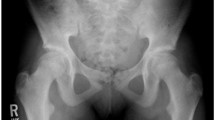Abstract
Recent studies have suggested that ultrasound examinations may improve diagnostic accuracy in congenital dislocation of the hip, but there is differing opinion whether ultrasound diagnosis should be based on morphology or stability. Ultrasound was added to the routine clinical screening in 1503 newborns (1291 girls and 212 boys). Hip morphology was classified according to Graf (type 1–4), while sonographic stability was based on a modified Barlow maneuvre, and classified as stable, elastic deflection (normal finding), unstable (provocating a gap between the femoral head and the acetabulum) and dislocated. Among 80 morphologically dysplastic hips, 73 (91%) were sonographically unstable or dislocated, while seven dysplastic hips were stable. On the other hand, in 49% of the sonographic unstable hips (69 out of 142) the acetabulum was either normal or just physiologically immature. 38 of these hips were left untreated and normalized spontaneously. There was a close correlation between sonographically and clinically determined hip stability (gamma = 0.95). Our study shows that the majority of morphologically dysplastic hips is sonographically unstable or dislocated, but also that morphologically dysplastic hips may be stable. Morphologically normal hips showing minor sonographic instability do probably not require treatment, and thus morphology seems to be an important diagnostic criterion.
Similar content being viewed by others
References
Palmen K (1984) Prevention of congenital dislocation of the hip. Act Orthop Scand 55 [Suppl]: 208
Bjerkreim I (1984) Functional treatment of congenital dislocation of the hip. Acta Orthop Scand 55 [Suppl]: 206
Wilkinson JA (1985) Congenital displacement of the hip joint. Springer, Heidelberg, p59–61
Barlow TG (1962) Early diagnosis and treatment of congenital dislocation of the hip. J Bone Joint Surg [Br] 44: 292–301
Wilkinson JA (1975) Failures in the management of congenital hip displacement in the new-born. Proc R Soc Med 68: 476–479
Graf R (1986) Sonographie der Säuglingshüfte. Ein Kompendium, 2nd edn. Enke, Stuttgart, pp 79, 91–97
Berman L, Klenerman L (1986) Ultrasound screening for hip abnormalities: preliminary findings in 1001 neonates. Br Med J 293: 719–722
Zieger M, Schulz RD (1987) Ultrasonography of the infant hip. Part III: Clinical application. Pediatr Radiol 17: 226
Dorn U, Hattwich M (1987) Sonographisches Hüftscreening bei Neugeborenen. Ultraschall Klin Prax 2: 159–164
Gomes H, Menanteau B, Motte J, Robiliard P (1987) Sonography of the neonatal hip: a dynamic approach. Ann Radiol 30: 503–510
Dahlström H, Øberg L, Friberg S (1986) Sonography in CDH. Acta Orthop Scand 557: 402–406
Harcke T, Grissom LE (1990) Performing dynamic sonography of the infant hip. AJR 155: 837–844
Rosendahl K, Markestad T, Lie RT (1992) Congenital dislocation of the hip: a prospective study comparing ultrasound and clinical examination. Acta Paediatr 81: 177–181
The Standing Medical Advisory Committee UHSS (1986) Screening for the detection of congenital dislocation of the hip. Arch Dis Child 61: 921–926
Dahlström H (1989) Dynamic ultrasonic evaluation of congenital hip dislocation. Umeå University Medical Dissertation No250
Zieger M, Hilpert S, Schulz RD (1986) Ultrasound of the infant hip. Part I. Basic principles. Pediatr Radiol 16: 483–487
Langer R (1987) Ultrasonic investigation of the hip in newborns in the diagnosis of congenital hip dislocation: classification and results of a screening program. Skeletal Radiol 16: 275–279
Terjesen T, Bredland T, Eik-Nes S (1988) Ultrasound examination of hip joints in newborns. Tidsskr Nor Lægefor 188: 2359–2363
Harcke HT, Clarcke MP, Lee MS et al. (1984) Examination of the infant hip with real-time ultrasonography. J Ultrasound Med 3: 131–137
Clarke NMP, Clegg J, Al-Chalabi AN (1989) Ultrasound screening of hips at risk for CDH. J Bone Joint Surg [Br] 71: 9–12
Gardiner HM, Dunn PM (1990) Controlled trial of immediate splinting versus ultrasonographic surveillance in congenitally dislocatable hips. Lancet 336: 1553–1556
Author information
Authors and Affiliations
Rights and permissions
About this article
Cite this article
Rosendahl, K., Markestad, T. & Lie, R.T. Ultrasound in the early diagnosis of congenital dislocation of the hip: The significance of hip stability versus acetabular morphology. Pediatr Radiol 22, 430–433 (1992). https://doi.org/10.1007/BF02013504
Received:
Accepted:
Issue Date:
DOI: https://doi.org/10.1007/BF02013504




